WEDNESDAY'S SCRIPT TIP:
THUNDERBALL THEORY

Amazon's Algorithm has just spit out the name of the NEW JAMES BOND!
Wallace Shawn!
In THE SECRETS OF ACTION SCREENWRITING Book, I have a thing that I call the “Thunderball Theory” which is kind of the reverse of Chekhov’s (Anton, not the STAR TREK guy) gun quote: “If in the first act you have a pistol hung on the wall, then in the following one it should be fired. Otherwise, don’t put it there.” Chekhov was talking about everything in a story having a purpose, and things that are planted paying off later. Things that pay off later need to be planted first - established. This removes coincidence. One of the things that I frequently say in my books is that “If you don’t show it, the audience can’t know it” - and the Thunderball Theory is about *demonstrating* that gun on the wall.
In the James Bond movie THUNDERBALL, the villain Largo steals *two* nuclear warheads, so that he can test one just to prove to the authorities that he’s not kidding. Hey, anyone can say that they are going to nuke a major city in the USA unless their demands are met, but how can we really know that they have a nuclear weapon? In the film, the second nuke is hidden somewhere in Miami, and James Bond must stop Largo before he kills all of the nice people in Miami. If that plot sounds familiar to you, it’s because it’s also the plot to James Cameron’s TRUE LIES, which also features a demonstration of the nuke on one of the Florida Keys before Ah-nuld has to save his wife and daughter and stop the villains from nuking Miami. What have these villains got against Miami?
But to reverse the gun on the wall thing, if your villain has some sort of high tech weapon, make sure he or she tests it earlier in the story so that we can see what it does. That will help us imagine what might happen to those poor people in Miami. In fact, any sort of weapon or device that the audience may not be familiar with needs to be demonstrated so that we understand how it works. In James Cameron’s ALIENS there’s a great scene where Hicks shows Ripley how to use a weapon, which not only explains how she knew how to use it later in the story, but gives us a chance to see the details of how the gun works.
But wait, Bill, I’m writing a serious drama - there are no evil villains with nuclear weapons set to blow up Miami! Can’t I just have stuff happen without being set up first? Mercy, what a question!
DEMONSTRATION BEFORE ACTION

In JUST MERCY (2019) idealistic young attorney Bryan Stevenson (Michael B. Jordan) sets up offices in Alabama along with Eva Ansley (Brie Larson) to help men on Death Row who may not have gotten a fair trial. The focus of the story is Walter McMillian (Jamie Foxx) an African American man who was convicted of murdering a white woman in 1986 solely on the testimony of a convicted felon named Ralph Myers (a great Tim Blake Nelson) who may have lied.
McMillian is initially without hope, “My last lawyer sat exactly where you are sittin’ and told me ‘Everything’s gonna be okay’. Then I was sentenced to death. Then my family run out of money. And then he gone. What you gone do different?” McMillian may not be educated, but he’s an intelligent man, who knows that his situation is about as close to hopeless as you can get. When he is sent back to his cell, we meet the prisoners in adjacent cells, and they discuss this new lawyer who is going to try and help them, older prisoner Herbert (Rob Morgan) and younger prisoner Anthony (O’Shea Jackson, jr). This scene contrasts McMillain’s pessimism with the other two death row inmates' optimism - they think that this new young attorney might help them get stays of executions or possibly even new trials. But as the story progresses, we see just how difficult it is for Stevenson to accomplish anything within the system when the same people who worked to convict McMillian in the first place are still the key people in that system. The judge who Stevenson needs to look at new evidence is the same judge who presided over the trail where McMillian was convicted. The same police officers who have access to the evidence that might exonerate McMillian were the ones who initially arrested him. None of these people want some young (Black) Harvard lawyer proving that they made a mistake. So Stevenson's first big case ends up being the fight of his life to save the life of a wrongly convicted death row inmate.
This doesn’t seem like the type of story that would need to use the Thunderball Theory, but it is. Because the concepts of Death Row and McMillain’s execution sometime in the future are not something within the audience’s experiences, so these remain abstract ideas unless we show it to them. But McMilain has been on Death Row for a while, and hasn’t received his execution orders... and the story itself is about saving him from that impending execution. And (spoiler!) Stevenson is successful by the end of the film. So we will never see an execution, and it will remain an abstract threat instead of a real one...
Except...
Remember those other two death row inmates, Herbert and Anthony? They aren’t just sounding boards for McMillain as he deals with the frustration of his new found hope, one of them is going to be that island in the Florida Keys where the villain Largo in THUNDERBALL tests the nuke to prove that he actually has one, and to demonstrate to James Bond and the audience the massive destruction power of the warhead. Just over halfway through the story, Herbert gets his execution orders. A date has been set. Now the pressure is on Stevenson to get a stay of execution against the clock - and he does his best... but the stay isn’t granted. Tomorrow Herbert will be put to death in the electric chair...
And we get a chilling sequence as they prepare the electric chair and test it...
But that isn’t enough for the Thunderball Theory - if we don’t show it, the audience can’t know it - so Herbert asks Stevenson to be a witness to his execution. The only friend the old man has is this young lawyer.
Another chilling scene as Herbert says his goodbyes to Anthony and McMillian before being taken to his death... And we see the whole horrible execution. The audience *experiences* the execution. We like Herbert, he’s a nice old guy, a war hero, who made a terrible mistake in anger, and is now going to be executed in front of us.
After the execution, both Stevenson and the audience know exactly what they are fighting to prevent. We have seen it, experienced it, felt the horror... and we don’t want that to happen to McMillian. The abstract concept of a man being executed has been shown to us, so that we can fully understand it... just as Largo blew up that island with one of the stolen warheads.
PREMISE PROMISE

Another aspect of the “Thunderball Theory” is fulfilling your promise to the audience. If Dennis Hopper in SPEED says he’s going to blow up that bus, the audience wants to see the bus explode. We’ve been thinking about that bus exploding for almost half the film - if it goes under 55mph it’s gonna blow - so the only way we will truly be satisfied is if it explodes. We’ve been thinking about it for too long to have it *not* explode. There was a time when an action movie could get by with the hero completely preventing the Villain’s Plan, but we live in the time of big spectacle entertainment. In AIR FORCE ONE, we want to see the plane crash into the ocean and disintegrate. You don’t want the hero to prevent all of the excitement! We want to see things blow up on screen! So, instead of cutting the red wire (no - the green one) you might have the hero thwart the Villain’s Plan by removing the bomb from a populated area to someplace where it can still blow up real good... just not hurt anyone. The threat of an explosion is kind of a promise you need to pay off - whether it’s having the villain demonstrate the bomb, or having the bus or plane or villain explode at the end. If you promise us an explosion, we want to see it... and I guess the same goes with an execution in JUST MERCY.
Because summer movies rely on spectacle, things tend to explode. In the films of yesteryear, the brave hero would stop the bomb before it went off. In modern films he's always a few minutes too late. Just like in THUNDERBALL and TRUE LIES, Graham Yost's BROKEN ARROW has terrorists steal two nukes from a stealth bomber. Even though Christian Slater and spunky Samantha Mathis scramble to disarm the first nuke, it goes off anyway. Why?
Two reasons from the story stand point:
1) To show the destructive power of the bomb, so that we know what will happen if the second bomb reaches Denver on that train.
2) Spectacle. The audience gets to experience a nuclear blast and live to tell about it. Wow!
Don't short change the audience by promising a nuclear explosion then not delivering. In the original script for my HBO World Premiere Movie CRASH DIVE! I blew up the Empire State Building and a Tom Hanks and Meg Ryan-like couple embracing on top of it... in the film, the Empire State Building still gets exploded real good, just without the rom-com couple. But I needed to fulfill the threat of the missile fired on New York City in order to satisfy the audience... and show them that the villains had a real threat that needed to be stopped by the hero.
UNFAMILIAR DEMONSTRATION

Another place where “Thunderball Theory” comes in handy is dealing with things that the audience is not familiar with. Just like the electrocution of a prisoner in JUST MERCY, most people have no idea what the Illudium Q-36 Explosive Space Modulator does in a science fiction movie, unless you have a scene that demonstrates it. Science fiction films are often filled with devices and concepts that are completely abstract to the audience unless they can see them in action. If you are writing a science fiction screenplay, make sure you show us how things works. Luke Skywalker practices with the light saber blindfolded at one point in STAR WARS, and we see what the device can do. Unfamiliar weapons or devices need to be demonstrated so that the audience can understand what they are. If you don’t show it, the audience can’t know it.
But it doesn’t have to be science fiction, any device from future or present or past that the audience may be unfamiliar with should probably be demonstrated in an earlier scene. My favorite episode of the 60s TV series THRILLER is similar to JUST MERCY in that it’s about a man on death row awaiting his fate... and hoping for a miracle reprieve. GUILLOTINE takes place in France is the past where a man accused of murdering his wife’s boyfriend is in his cell, soon to be executed. His cell mate is also waiting for his date with the blade. The rumor is that they come in the middle of the night and take you away - where you are cleaned up, given a last meal, and a shave and a haircut... before you get your neck cut. The barber is supposed to draw a line on the back of your neck while cutting your hair, to show where your neck needs to be in the stockade for the perfect beheading. Since the audience in 1960s America probably wasn’t familiar with death by guillotine, our hero and his cell mate are interrupted in the middle of the night by a pair of guards who sneak into the cell while both are asleep, and grabs one of them - pulling him out kicking and screaming! Not our hero, but the cell mate. Just like in JUST MERCY, we get a “preview” of what might happen to our hero... as the blade slices down on the cell mate’s neck! Later in the episode, to remind us, they test the guillotine on a cabbage before our hero has his date with fate! So whether it is the past or present or future, anything that the audience may not be familiar with should probably be demonstrated earlier in the story.
The “Thunderball Theory” also holds true with Odd Job’s derby in the James Bond film GOLDFINGER - there’s a swell scene at the country club where he demonstrates what his razor rimmed hat can do by throwing it at a statue - and beheading it! From that point on, the audience is waiting for the scene where James Bond and Odd Job fight, and Odd Job takes off his hat and zips it at Bond’s neck! As with anything that you plant in a story so that it can pay off later, it’s important that the “plant” be motivated and part of the story that you are telling - so that it isn’t obviously just to set something up for later. Why the heck is there a gun on the wall in the first place? You need to make sure that the gun on the wall in Act 1 is an important part of that scene. You don’t want the audience to think that you are just using it to set up a later scene - you need it to be important in *this* scene!
Whether your story is about James Bond preventing Largo from nuking Miami or an idealistic young lawyer trying to prove that a man on death row in Alabama is innocent in JUST MERCY, the “Thunderball Theory” is an important part of your story - if there is a gun that goes off in Act 3, you need to show the audience how that gun works in Act 1 or 2. If you don’t show it, the audience can’t know it!
BRAND NEW!
How Do I do That?

101 SCREENWRITING ANSWERS Blue Book!
New to screenwriting? You probably have questions! How do I get an Agent? How do I write a phone conversation? Do I need a Mentor? What’s does VO and OC and OS mean? What is proper screenplay format? Should I use a pen name? Do I need to movie to Hollywood? What’s the difference between a Producer and a Production Manager, and which should I sell my script to? How do I write a Text Message? Should I Copyright or WGA register my script? Can I Direct or Star? How do I write an Improvised scene? Overcoming Writer’s Block? How do I write a Sex Scene? And many many more! This book has the answers to the 101 Most Asked Questions from new screenwriters! Everything you need to know to begin writing your screenplay!
All of the answers you need to know, from a working professional screenwriter with 20 produced films and a new movie made for a major streaming service in 2023!
Only $4.99
NEW!!!
Can You Make It bigger?

BLOCKBUSTERS (and BEACH READS) Blue Book!
Writing something EPIC?
ONLY: $4.99!
Thinking about writing a big Disaster Movie? An Historical Epic? An Epic Adventure Film? Or maybe you like Gladiator Movies? This book looks at writing Blockbusters and those Big Fat Beach Read novels - anything epic! Usng movies like JAWS, POSEIDON ADVENTURE, LAWRENCE OF ARABIA, THE GUNS OF NAVARONE, and those MARVEL and FAST & FURIOUS flicks as examples. What *is* a Blockbuster? 107 years of Blockbuster history! Blockbuster Characters. Blockbuster Story Types! Why modern Blockbusters are soap operas! Social Issues in Blcokbusters? Big Emotions! Keeping All Of Those Characters Distinctive! How to avoid the Big problems found in Big Movies and books! More! If you are writing a Big Event Movie or a Big Fat Novel, there are tips and techniques to help you!
Only $4.99
BRAND NEW!
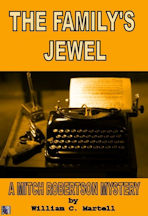
***
MITCH ROBERTSON #2: THE FAMILY'S JEWEL *** - For Kindle!
"The Presidential Suite of the Hollywood Hoover Hotel looked like a bloody battlefield: bodies everywhere, furniture broken, red liquid dripping from the walls, dead soldiers littering the elegant Berber rug as clouds of smoke overhead bounced between two air conditioning vents.
Mitch Robertson stepped over the body of an ex-child star turned sex tape star turned pop star and entered the room, spotted a gun on the floor and picked it up... careful not to spill his coffee with three pumps of mocha syrup from Penny’s Coffee Shop. That coffee was gold, the only thing keeping him going in this dazed state of wakefulness. The gun felt light. Holding it, he saw the silhouette of an 80s action star sitting sideways on a tipped over chair. Motionless. Was he dead? Mitch was still hung over from the Awards Party the night before, and wondered whether this was all some sort of crazy nightmare that he would wake up from... but when he tripped over the brown legs of a bottomless Superhero, flaccid junk encased in a condom but still wearing his mask, and hit the edge of the sofa, gun skittering and coffee spilling, he realized that it was all very real. What the hell had happened here?"
Short Novel. Only 99 cents - and no postage!
IT'S NEW!!
All About Rewrites!
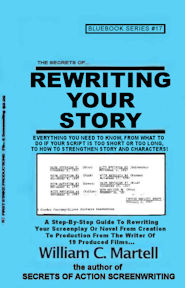
REWRITES Blue Book!
Rewriting In Waves?
When You Finish Your Screenplay Or Novel...
The Rewrites Begin!
The end is just the beginning! You’ve finished your story, but now the rewriting begins! This 405 page book shows you how to rewrite your screenplay or novel to perfection. Everything from Character Consistency to Shoeboxing to How To Give And Receive Notes to 15 Solutions If Your Script’s Too Long! and 15 Solutions If Your Script’s Too Short! to Finding The Cause Of A Story Problem to Good Notes Vs. Bad Notes to Finding Beta Readers to Avoiding Predictability to Learning To Be Objective About Your Work to Script Killer Notes and Notes From Idiots to Production Rewrites and What The Page Colors Mean? and a Complete Rewrite Checklist! The complete book on Rewriting Your Story!
Only: $4.99
HITCHCOCK FOR WRITERS!
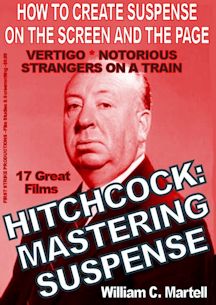
LEARN SUSPENSE FROM THE MASTER!
*** HITCHCOCK: MASTERING SUSPENSE *** - For Kindle!
Alfred Hitchcock, who directed 52 movies, was known as the *Master Of Suspense*; but what exactly is suspense and how can *we* master it? How does suspense work? How can *we* create “Hitchcockian” suspense scenes in our screenplays, novels, stories and films?
This book uses seventeen of Hitchcock’s films to show the difference between suspense and surprise, how to use “focus objects” to create suspense, the 20 iconic suspense scenes and situations, how plot twists work, using secrets for suspense, how to use Dread (the cousin of suspense) in horror stories, and dozens of other amazing storytelling lessons. From classics like “Strangers On A Train” and “The Birds” and “Vertigo” and “To Catch A Thief” to older films from the British period like “The 39 Steps” and “The Man Who Knew Too Much” to his hits from the silent era like “The Lodger” (about Jack The Ripper), we’ll look at all of the techniques to create suspense!
Only $5.99
NO KINDLE REQUIRED! Get the *free* app (any device, except your Mr. Coffee) on the order page on Amazon!
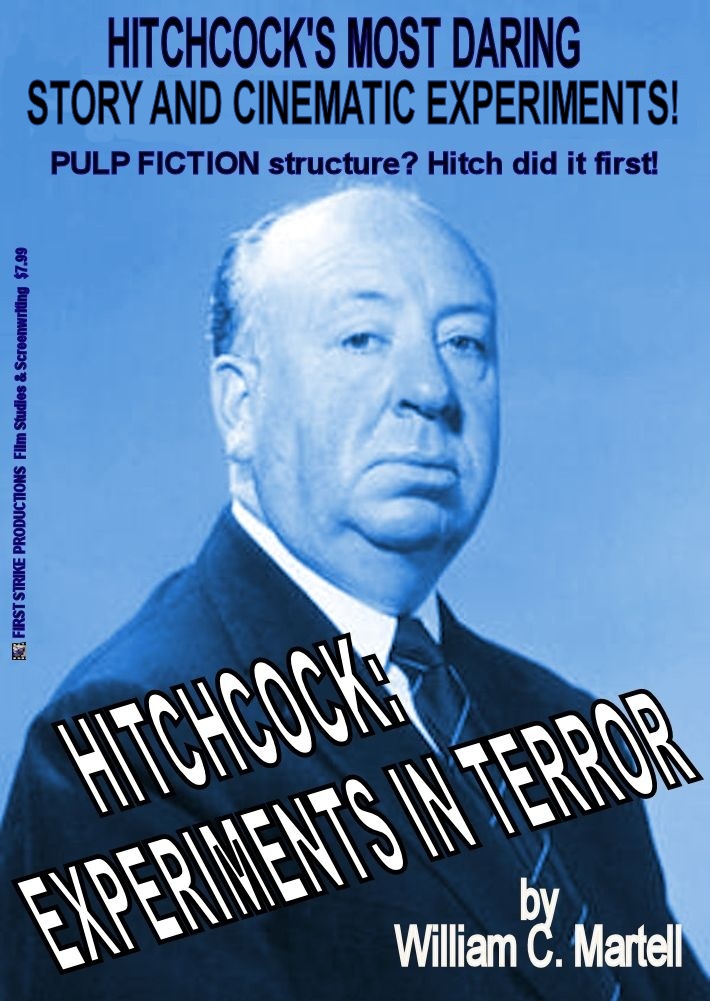
Strange Structures!
*** HITCHCOCK: EXPERIMENTS IN TERROR! *** - For Kindle!
***
Contained Thrillers like "Buried"? Serial Protagonists like "Place Beyond The Pines"? Multiple Connecting Stories like "Pulp Fiction"? Same Story Multiple Times like "Run, Lola, Run"?
HITCHCOCK DID IT FIRST!
This book focuses on 18 of Hitchcock's 52 films with wild cinema and story experiments which paved the way for modern films. Almost one hundred different experiments that you may think are recent cinema or story inventions... but some date back to Hitchcock's *silent* films! We'll examine these experiments and how they work. Great for film makers, screenwriters, film fans, producers and directors.
Only $5.99 - and no postage!
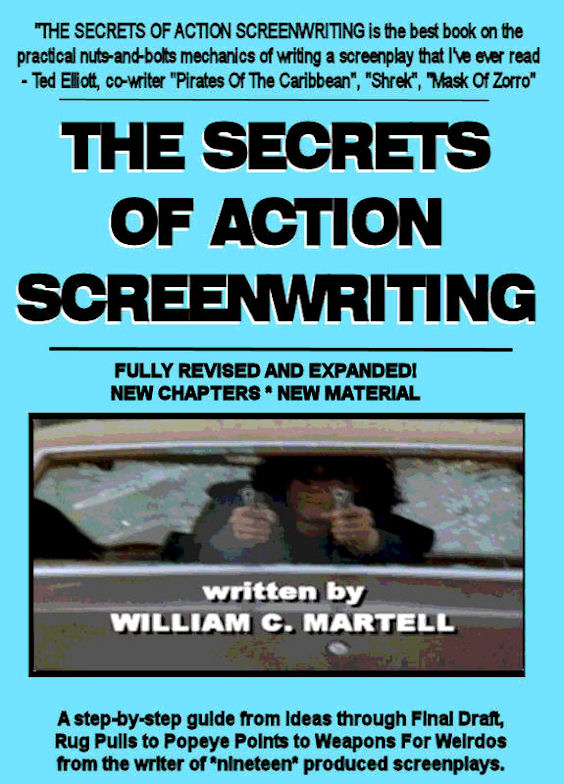
MAKES A GREAT GIFT!
*** THE SECRETS OF ACTION SCREENWRITING *** - For Kindle!
*** THE SECRETS OF ACTION SCREENWRITING *** - For Nook!
Why pay $510 for a used version of the 240 page 2000 version that used to retail for $21.95? (check it out!) when
you can get the NEW EXPANDED VERSION - over 500 pages - for just $9.99? New chapters, New examples, New techniques!
"SECRETS OF ACTION SCREENWRITING is the
best book on the practical nuts-and-bolts mechanics of writing a screenplay I've ever read."
- Ted Elliott, co-writer of MASK OF ZORRO, SHREK, PIRATES OF THE CARIBBEAN and the sequels (with Terry Rossio). (ie; 4 of the top 20 Box Office Hits Of ALL TIME.)
Only $9.99 - and no postage!
Tip FAQ

My New Script Secrets Newsletter!

STORY IN ACTION SERIES!

THE MISSION IMPOSSIBLE MOVIES
NEW: Updates On Films 7 & 8 Casting!
All Six Movies analyzed! All of the mission tapes, all of the “that’s impossible!” set pieces and stunts, the cons and capers - and how these scenes work, the twists and double crosses, the tension and suspense (and how to generate it), the concept of each film as a stand alone with a different director calling the shots (broken in the sixth film), the gadgets, the masks, the stories, the co-stars and team members (one team member has been in every film), the stunts Tom Cruise actually did (and the ones he didn’t), and so much more! Over 120,000 words of fun info!
THE MISSION IMPOSSIBLE MOVIES - 347 Pages - Only $3.99 !

BRAND NEW!
*** THE BOURNE MOVIES
NEW: Updates on TREADSTONE TV show!
All five "Bourne" movies (including "Legacy" and it's potential sequels) - what are the techniques used to keep the characters and scenes exciting and involving? Reinventing the thriller genre...
or following the "formula"? Five films - each with an interesting experiment! A detailed analysis of each
of the films, the way these thrillers work... as well as a complete list of box office and critical
statistics for each film. This book is great for writers, directors, and just fans of the series.
Only $3.99 - and no postage!
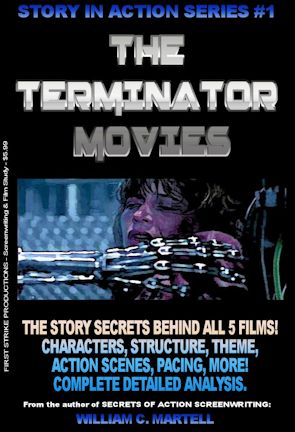
Over 240 pages!
*** THE TERMINATOR MOVIES *** - For Kindle!
He's back! The release of "Terminator: Dark Fate" is set to begin a new trilogy in
the Terminator story... 35 years after the first film was released. What draws us to these films about
a cybernetic organism from the future sent back in time? Why is there a new proposed trilogy every few
years? This book looks at all five Terminator movies from a story standpoint - what makes them work
(or not)? What are the techniques used to keep the characters and scenes exciting and involving? How
about those secret story details you may not have noticed? Containing a detailed analysis of each of
the five films so far, this book delves into the way these stories work... as well as a complete list of
box office and critical statistics for each film. This book is great for writers, directors, and just
fans of the series.
ONLY $3.99 - and no postage!
NO KINDLE REQUIRED! Get the *free* app (any device, except your Mr. Coffee) on the order page on Amazon!

NEW BUT OLD!
*** VINTAGE #1: HOW TO WRITE PHOTOPLAYS *** - For Kindle!
***
Screenwriting books have been around as long as films have. This series reprints vintage screenwriting books with a new introduction and history, plus new articles which look at how these lessons from almost 100 years ago apply to today’s screenplays. Anita Loos book is filled with information which still applies.
In addition to the full text of the original book, you get the full screenplay to Miss Loos' hit THE LOVE EXPERT, plus several new articles on the time period and women in Hollywood.
Only $2.99 - and no postage!
THE BLUE BOOKS!
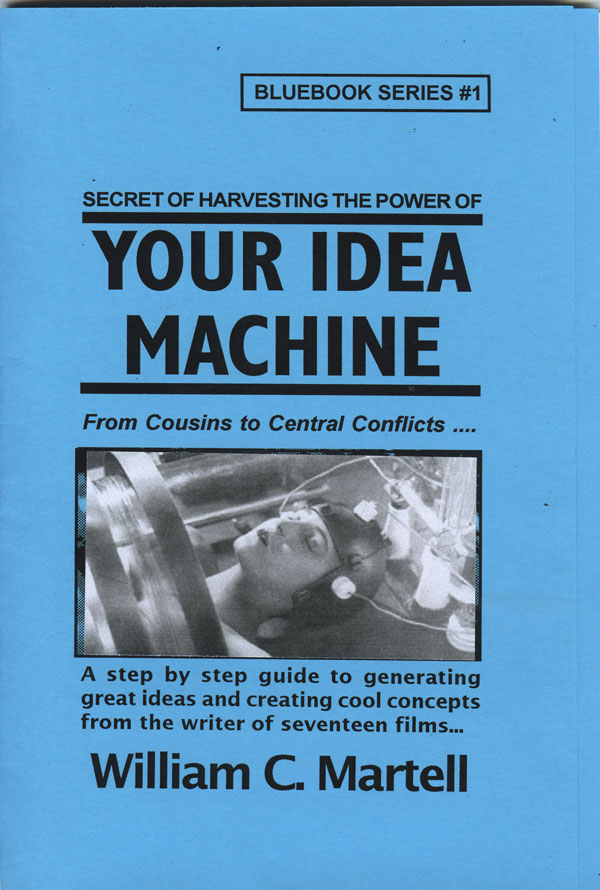
FIND A GREAT IDEA!
*** YOUR IDEA MACHINE *** - For Kindle!
****
Expanded version with more ways to find great ideas! Your screenplay is going to begin with an idea. There are good ideas and bad ideas and commercial ideas and personal ideas. But where do you find ideas in the first place? This handbook explores different methods for finding or generating ideas, and combining those ideas into concepts that sell. The Idea Bank, Fifteen Places To Find Ideas, Good Ideas And Bad Ideas, Ideas From Locations And Elements, Keeping Track Of Your Ideas, Idea Theft - What Can You Do? Weird Ways To Connect Ideas, Combing Ideas To Create Concepts, High Concepts - What Are They? Creating The Killer Concept, Substitution - Lion Tamers & Hitmen, Creating Blockbuster Concepts, Magnification And The Matrix, Conflict Within Concept, Concepts With Visual Conflict, Avoiding Episodic Concepts, much more! Print version is 48 pages, Kindle version is over 175 pages!
Only $4.99 - and no postage!
FIGURE OUT YOUR STORY!
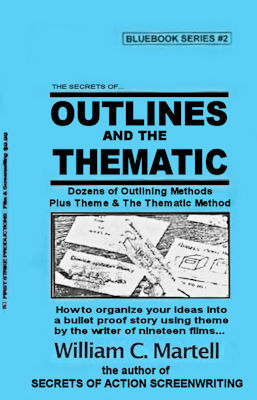
OUTLINES & THE THEMATIC Blue Book.
ARE YOUR SCENES IN THE RIGHT ORDER?
AND ARE THEY THE RIGHT SCENES?
Your story is like a road trip... but where are you going? What's the best route to get there? What are the best sights to see along the way? Just as you plan a vacation instead of just jump in the car and start driving, it's a good idea to plan your story. An artist does sketches before breaking out the oils, so why shouldn't a writer do the same? This Blue Book looks at various outlining methods used by professional screenwriters like Wesley Strick, Paul Schrader, John August, and others... as well as a guest chapter on novel outlines. Plus a whole section on the Thematic Method of generating scenes and characters and other elements that will be part of your outline. The three stages of writing are: Pre-writing, Writing, and Rewriting... this book looks at that first stage and how to use it to improve your screenplays and novels.
Only $4.99 - and no postage!
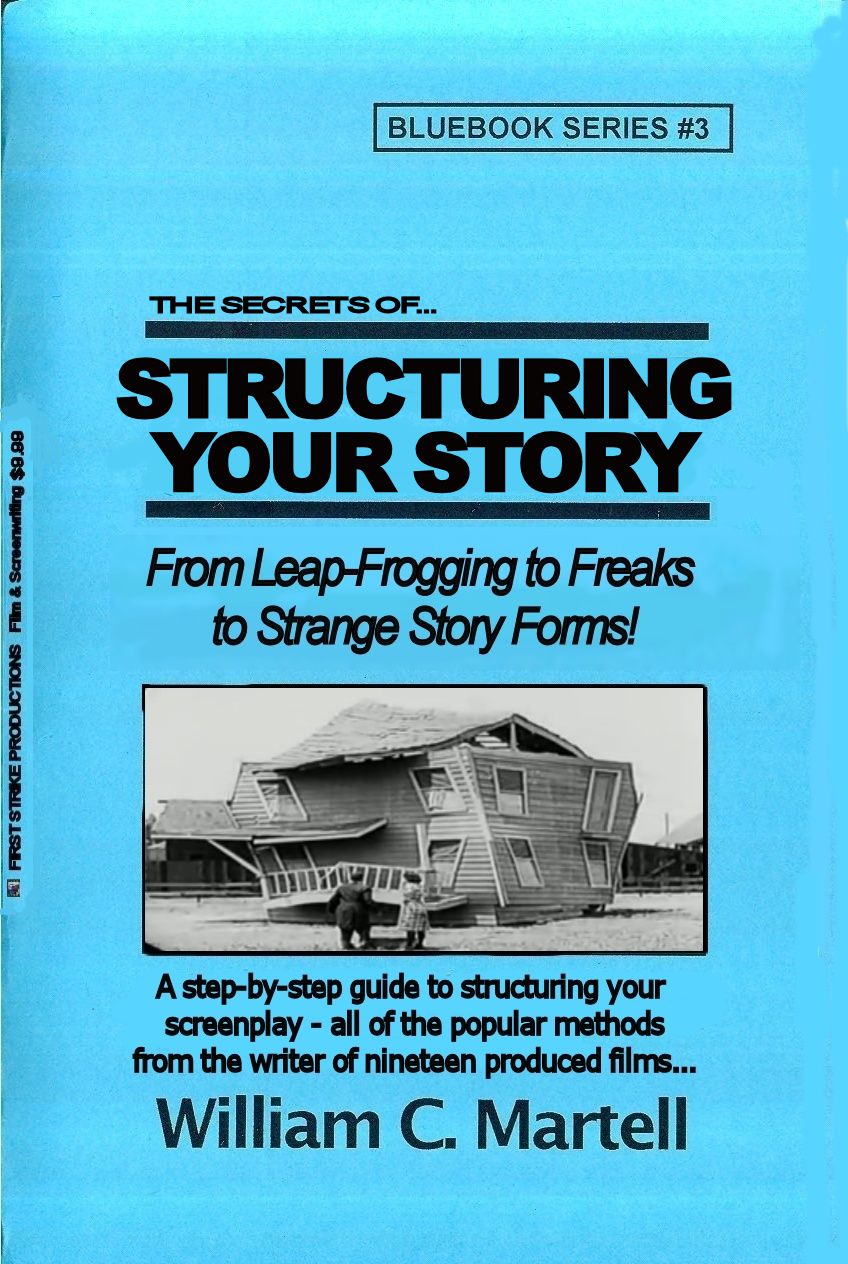
GOT STRUCTURE?!
*** STRUCTURING YOUR STORY *** - For Kindle!
William Goldman says the most important single element of any screenplay is structure. It’s the skeleton under the flesh and blood of your story. Without it, you have a spineless, formless, mess... a slug! How do you make sure your structure is strong enough to support your story? How do you prevent your story from becoming a slug? This Blue Book explores different types of popular structures from the basic three act structure to more obscure methods like leap-frogging. We also look at structure as a verb as well as a noun, and techniques for structuring your story for maximum emotional impact. Most of the other books just look at *structure* and ignore the art of *structuring* your story. Techniques to make your story a page turner... instead of a slug!
Only $4.99 - and no postage!

STORY: WELL TOLD!
*** STORY: WELL TOLD *** - For Kindle!
This book takes you step-by-step through the construction of a story... and how to tell a story well, why Story always starts with character... but ISN'T character, Breaking Your Story, Irony, Planting Information, Evolving Story, Leaving No Dramatic Stone Unturned, The Three Greek Unities, The Importance Of Stakes, The Thematic Method, and how to create personal stories with blockbuster potential. Ready to tell a story?
Print version was 48 pages, Kindle version is over 85,000 words - 251 pages!
Only $4.99 - and no postage!

START STRONG!
*** HOOK 'EM IN TEN *** - For Kindle!
Your story doesn't get a second chance to make a great first impression, and this book shows you a
bunch of techniques on how to do that. From the 12 Basic Ways To Begin Your Story, to the 3 Stars Of
Your First Scene (at least one must be present) to World Building, Title Crawls, Backstory, Starting
Late, Teasers and Pre Title Sequences, Establishing Theme & Motifs (using GODFATHER PART 2), Five Critical
Elements, Setting Up The Rest Of The Story (with GODFATHER), and much more! With hundreds of examples
ranging from Oscar winners to classic films like CASABLANCA to some of my produced films (because
I know exactly why I wrote the scripts that way). Biggest Blue Book yet!
Print version was 48 pages, Kindle version is over 100,000 words - 312 pages!
Only $4.99 - and no postage!
NO KINDLE REQUIRED! Get the *free* app (any device, except your Mr. Coffee) on the order page on Amazon!
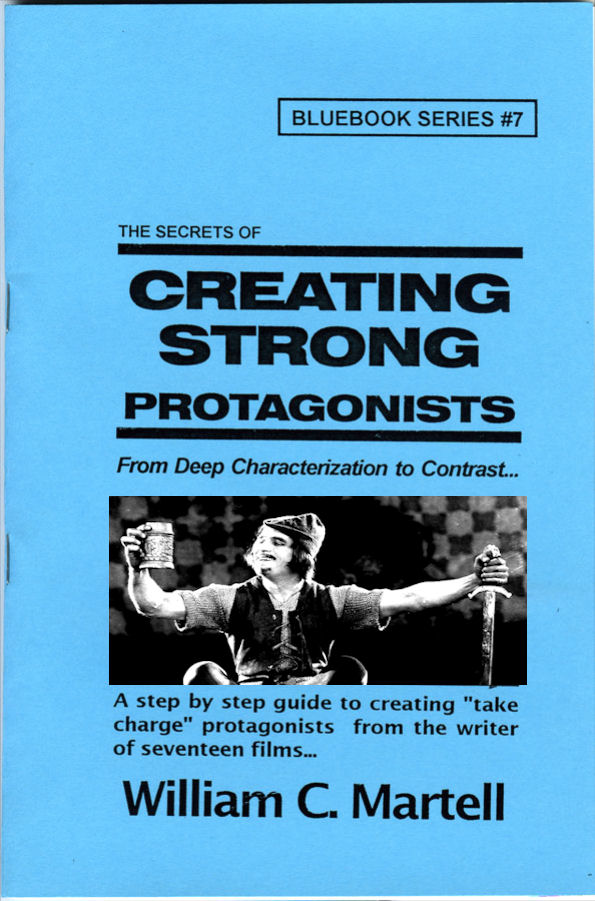
MOVIES ARE CHARACTERS!
*** CREATING STRONG PROTAGONISTS *** - For Kindle!
*** CREATING STRONG PROTAGONISTS *** - For Nook!
Expanded version with more ways to create interesting protagonists! A step-by-step guide to creating "take charge" protagonists. Screenplays are about characters in conflict... characters in emotional turmoil... Strong three dimensional protagonists who can find solutions to their problems in 110 pages. But how do you create characters like this? How do you turn words into flesh and blood? Character issues, Knowing Who Is The Boss, Tapping into YOUR fears, The Naked Character, Pulp Friction, Man With A Plan, Character Arcs, Avoiding Cliche People, Deep Characterization, Problem Protagonists, 12 Ways To Create Likable Protagonists (even if they are criminals), Active vs. Reactive, The Third Dimension In Character, Relationships, Ensemble Scripts, and much, much more. Print version is 48 pages, Kindle version is once again around 205 pages!
ONLY $4.99 - and no postage!
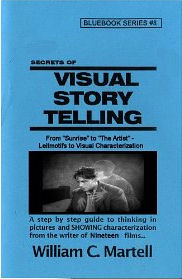
I WRITE PICTURES!
*** VISUAL STORYTELLING *** - For Kindle! (exclusive)
Show Don't Tell - but *how* do you do that? Here are techniques to tell stories visually! Using Oscar Winning Films and Oscar Nominated Films as our primary examples: from the first Best Picture Winner "Sunrise" (1927) to the Oscar Nominated "The Artist" (which takes place in 1927) with stops along the way Pixar's "Up" and Best Original Screenplay Winner "Breaking Away" (a small indie style drama - told visually) as well as "Witness" and other Oscar Winners as examples... plus RISE OF THE PLANET OF THE APES. Print version is 48 pages, Kindle version is over 200 pages!
ONLY $4.99 - and no postage!
DESCRIPTION & VOICE Blue Book!
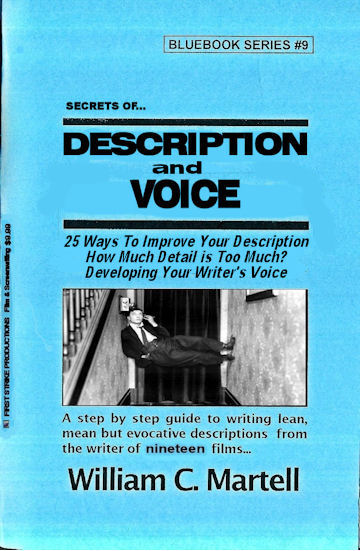
DESCRIPTION & VOICE Blue Book.
IS HALF OF YOUR STORY IN TROUBLE?
Most screenplays are about a 50/50 split between dialogue and description - which means your description is just as important as your dialogue. It just gets less press because the audience never sees it, the same reason why screenwriters get less press than movie stars. But your story will never get to the audience until readers and development executives read your script... so it is a very important factor. Until the movie is made the screenplay is the movie and must be just as exciting as the movie. So how do you make your screenplay exciting to read? Description is important in a novel as well, and the “audience” does read it... how do we write riveting description?
Only $4.99 and no postage!

PRO DIALOGUE TECHNIQUES!
*** DIALOGUE SECRETS *** - For Kindle!
***
Expanded version with more ways to create interesting dialogue! How to remove bad dialogue (and what *is* bad dialogue), First Hand Dialogue, Awful Exposition, Realism, 50 Professional Dialogue Techniques you can use *today*, Subtext, Subtitles, Humor, Sizzling Banter, *Anti-Dialogue*, Speeches, and more. Tools you can use to make your dialogue sizzle! Special sections that use dialogue examples from movies as diverse as "Bringing Up Baby", "Psycho", "Double Indemnity", "Notorious", the Oscar nominated "You Can Count On Me", "His Girl Friday", and many more! Print version is 48 pages, Kindle version is over 175 pages!
Only $4.99 - and no postage!

WHAT IS A SCENE?
*** SCENE SECRETS *** - For Kindle!
***
What is a scene and how many you will need? The difference between scenes and sluglines. Put your scenes on trial for their lives! Using "Jaws" we'll look at beats within a scene. Scene DNA. Creating set pieces and high concept scenes. A famous director talks about creating memorable scenes. 12 ways to create new scenes. Creating unexpected scenes. Use dramatic tension to supercharge your scenes. Plants and payoffs in scenes. Plus transitions and buttons and the all important "flow"... and more! Over 65,000 words! Print version was 48 pages, Kindle version is around 210 pages!
Only $4.99 - and no postage!
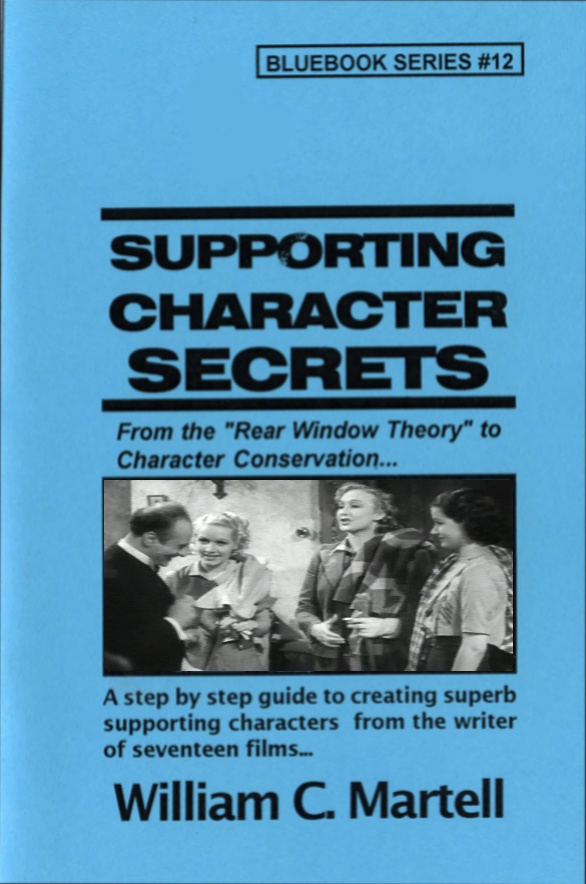
SUBPLOTS?
*** SUPPORTING CHARACTER SECRETS *** - For Kindle! (Exclusive)
Expanded version with more techniques to flesh out your Supporting Characters and make them individuals. Using the hit movie BRIDESMAIDS as well as other comedies like THE HANGOVER and TED and HIGH FIDELITY and
40 YEAR OLD VIRGIN and many other examples we look at ways to make your Supporting Characters come alive on the page.
Print version was 48 pages, Kindle version is around 170 pages!
ONLY $4.99 - and no postage!
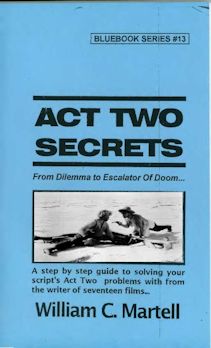
ACT TWO SOLUTIONS!
*** ACT TWO SECRETS *** - For Kindle!
Expanded version with more techniques to help you through the desert of Act Two! Subjects Include: What Is Act Two? Inside Moves, The 2 Ps: Purpose & Pacing, The 4Ds: Dilemma, Denial, Drama and Decision, Momentum, the Two Act Twos, Subplot Prisms, Deadlines, Drive, Levels Of Conflict, Escalation, When Act Two Begins and When Act Two Ends, Scene Order, Bite Sized Pieces, Common Act Two Issues, Plot Devices For Act Two, and dozens of others. Over 67,000 words (that’s well over 200 pages) of tools and techniques to get you through the desert of Act Two alive!
Print version was 48 pages, Kindle version is well over 200 pages!
ONLY $4.99 - and no postage!
All About Endings!
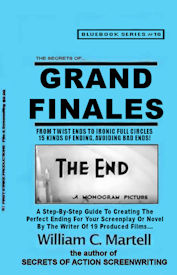
GRAND FINALES Blue Book!
The Perfect Ending For Your Story!
The First Ten Pages Of Your Screenplay Are Critical,
But What About The Last 10 Pages?
Creating the perfect ending to your story! This 100,000 word book shows you how to end your story with a bang, rather than a whimper. Everything from Resolution Order to Act Three Tools to Happy or Sad Endings? to How The Beginning Of Your Story Has Clues To The Ending (in case you were having trouble figuring out how the story should end) to Falling Action to How To Avoid Bad Endings to Writing The Perfect Twist Ending to Setting Up Sequels & Series to Emotional Resolutions to How To Write Post Credit Sequences to Avoiding Deus Ex Machinas, to 20 Different Types Of Ends (and how to write them) and much more! Everything about endings for your screenplay or novel!
Only: $4.99
NO KINDLE REQUIRED! Get the *free* app (any device, except your Mr. Coffee) on the order page on Amazon!
All About LOGLINES, TREATMENTS, and PITCHING!

LOGLINES, TREATMENTS, and PITCHING! Blue Book!
Distilling Your Screenplay!
Loglines, Treatments, Pitching, Look Books, Pitch Decks, One Pagers, Rip-O-Matics?
You have written a brilliant 110 page screenplay, but how do you get anyone to read it? You need to distill it down into some form of verbal moonshine or story rocket fuel that will ignite that bored development executive or manager or agent and get them to request your screenplay. But how do you shrink those 110 pages into a 25 word logline or a 2 minute elevator pitch or a one page synopsis or a short paragraph? This 100,000 word book shows you how! Everything you need to know! From common logline mistakes (and how to solve them) to how your pitch can reveal story problems to the 4 types of pitches!
272 Pages - ONLY $4.99!
READY TO BREAK IN?
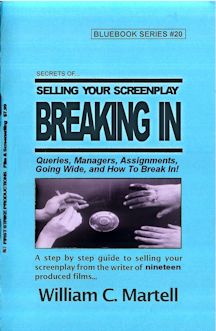
THE BUISINESS SIDE
*** BREAKING IN BLUE BOOK *** - For Kindle!
Should really be called the BUSINESS BLUE BOOK because it covers almost everything you will need to
know for your screenwriting career: from thinking like a producer and learning to speak their language,
to query letters and finding a manager or agent, to making connections (at home and in Hollywood) and
networking, to the different kinds of meetings you are will have at Studios, to the difference between
a producer and a studio, to landing an assignment at that meeting and what is required of you when you
are working under contract, to contracts and options and lawyers and... when to run from a deal!
Information you can use *now* to move your career forward! It's all here in the Biggest Blue Book yet!
Print version was 48 pages, Kindle version is over 400 pages!
$4.99 - and no postage!

Use your creative energy to focus on the content; let Final Draft take care of the style. Final Draft is the number-one selling application specifically designed for writing movie scripts, television episodics and stage plays. Its ease-of-use and time-saving features have attracted writers for almost two decades positioning Final Draft as the Professional Screenwriters Choice. Final Draft power users include Academy, Emmy and BAFTA award winning writers like Oliver Stone, Tom Hanks, Alan Ball, J.J. Abrams, James Cameron and more.
* * * Buy It!
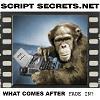
|
|
|
|
|
SECRETS OF ACTION SCREENWRITING
|
|
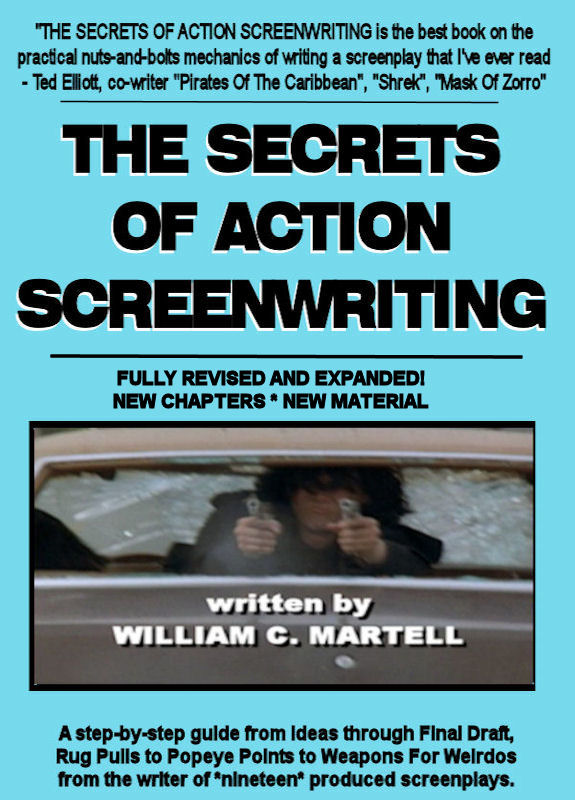 IT'S BACK! SECRETS OF ACTION SCREENWRITING
IT'S BACK! SECRETS OF ACTION SCREENWRITING
Over 460 pages packed with tips and techniques.
How to
write a plot twist,
the four kinds of suspense (and how to create it), reversals, ten ways to invent new action scenes, secrets and lies,
creating the ultimate
villain, five kinds of love interests, MORE! CLICK HERE!
|
|
CLASSES ON MP3
|
|
 CLASSES ON MP3! Take a class on MP3! GUERRILLA MARKETING - NO AGENT? NO PROBLEM! and WRITING THRILLERS (2 MP3s). Full length classes on MP3. Now Available: IDEAS & CREATIVITY, WRITING HORROR, WRITING INDIE FILMS, more!
CLASSES ON MP3! Take a class on MP3! GUERRILLA MARKETING - NO AGENT? NO PROBLEM! and WRITING THRILLERS (2 MP3s). Full length classes on MP3. Now Available: IDEAS & CREATIVITY, WRITING HORROR, WRITING INDIE FILMS, more!
Take classes on MP3!
|
|
MY OTHER SITES
|
|
B MOVIE WORLD
Cult Films, Exploitation, Bikers & Women In Prison, Monster Movies.
FIRST STRIKE PRODUCTIONS
Producing my own scripts, investment possibilities, pipe dreams.
|
|
NAKED SCREENWRITING MP3s
|
|
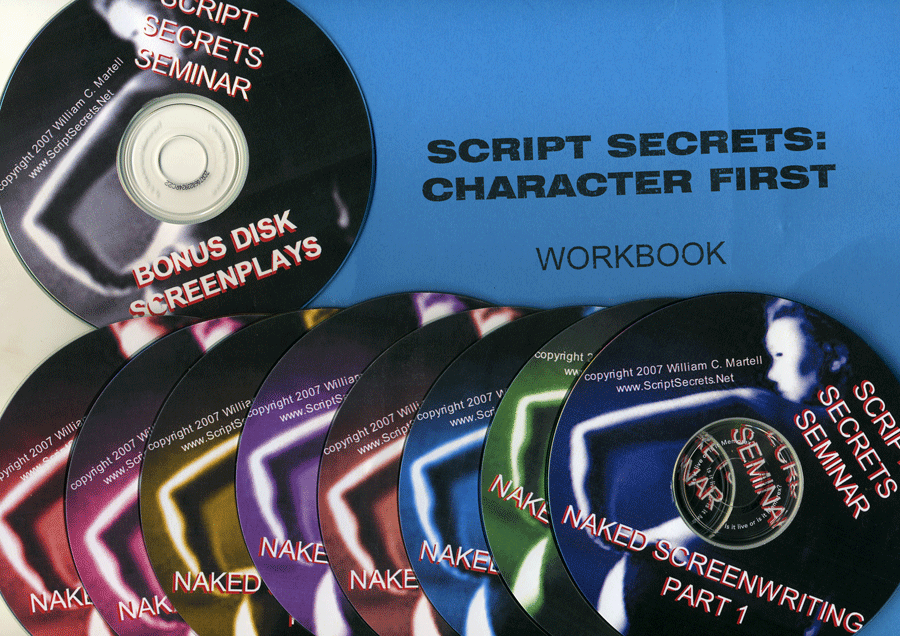 The NAKED SCREENWRITING CLASS ON MP3!
The 2001 London Class on 8 MP3s! Recorded *live* the morning after the Raindance Film Festival
wrapped. The two day class on 8CD worth, plus a workbook, plus a bonus CD.
The NAKED SCREENWRITING CLASS ON MP3!
The 2001 London Class on 8 MP3s! Recorded *live* the morning after the Raindance Film Festival
wrapped. The two day class on 8CD worth, plus a workbook, plus a bonus CD.
The 2 Day Class on MP3!
|
|
ONLINE CLASSES
|
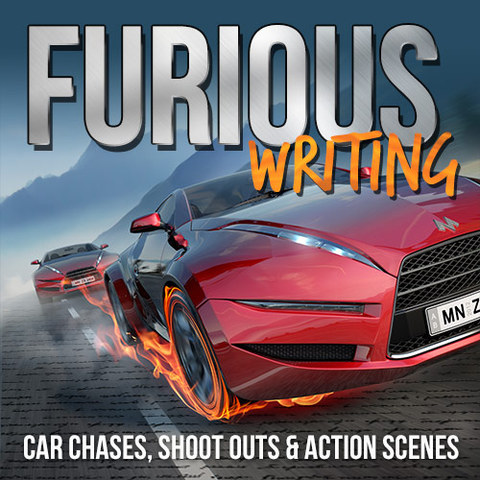
|
|
BILL'S CORNER
|
|
My
nineteen produced films, interviews with me in magazines,
several sample scripts, my available scripts list... And MORE!
...............................BILL'S CORNER
Available Scripts
|
|
E BOOKS PAGE
|
|
 E BOOKS: New Blue Books and Novelettes!
E BOOKS: New Blue Books and Novelettes!
I am expanding all of the Blue Books from around 44 pages of
text to around 200 pages! Some are over 250 pages! See what is availabale and what is coming soon!Also, I've been writing Novelletes and there
will soon be novels.
E BOOKS: BLUE BOOKS & NOVELLETES
|
|
BOOKLETS & PRODUCTS
|
|
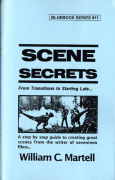 FIRST STRIKE BLUE BOOKS
FIRST STRIKE BLUE BOOKS
Each Blue Book is 48
pages and focuses on a different aspect of screenwriting. Dialogue. Visual Storytelling. Your First Ten Pages. Act 2 Booster. Protagonists. Great Endings.
Seventeen Blue Books now available!
THE SECRETS OF ACTION SCREENWRITING OUT OF PRINT!
|
|
|
|
|

